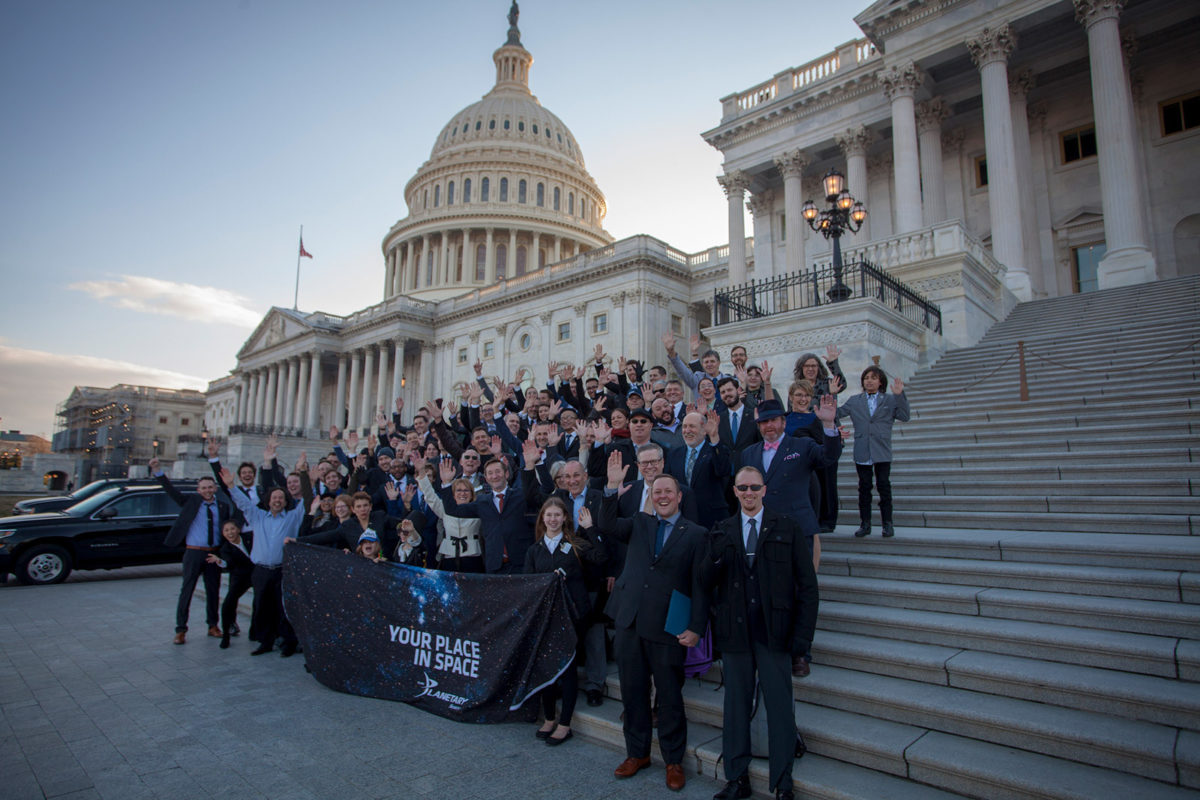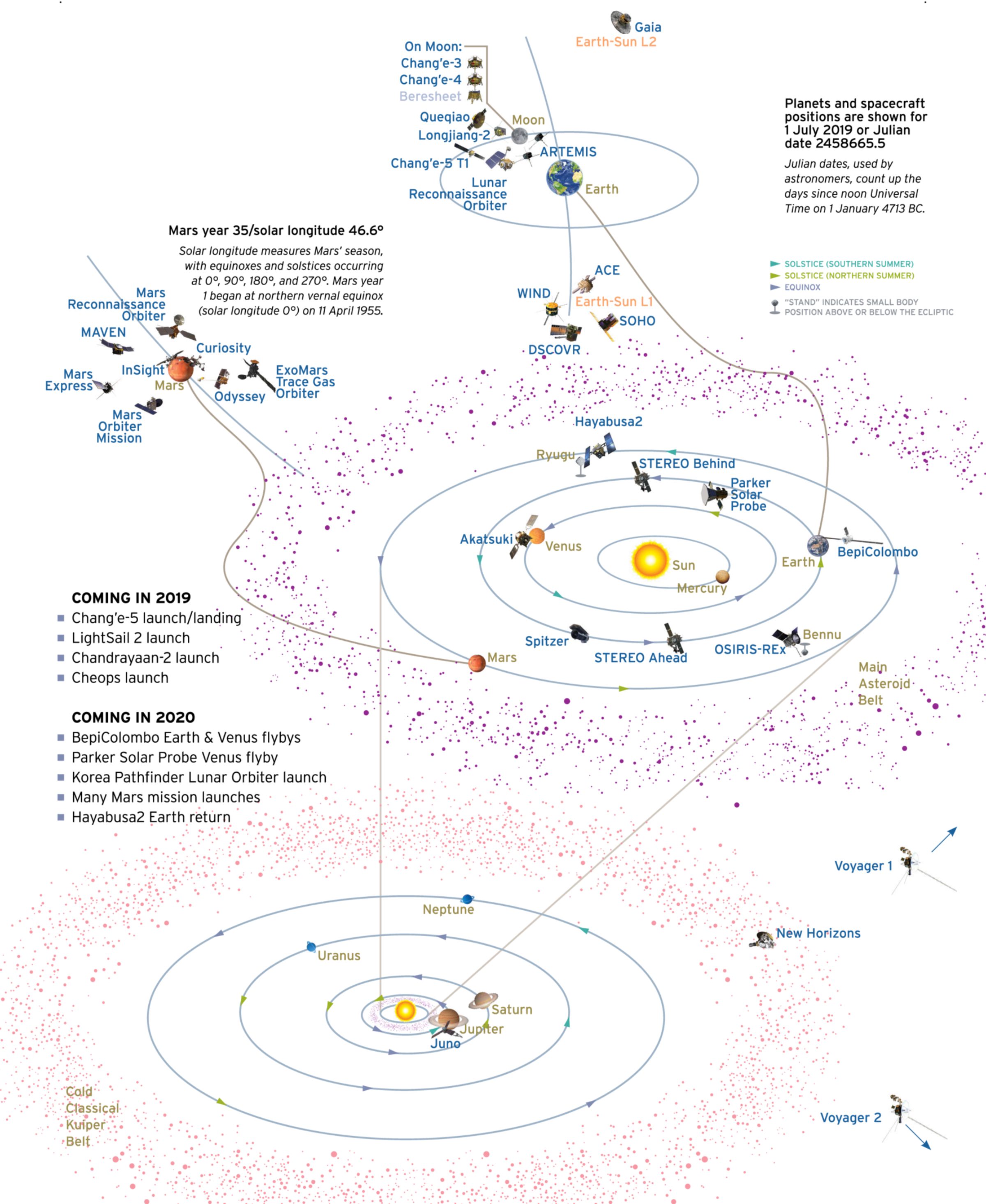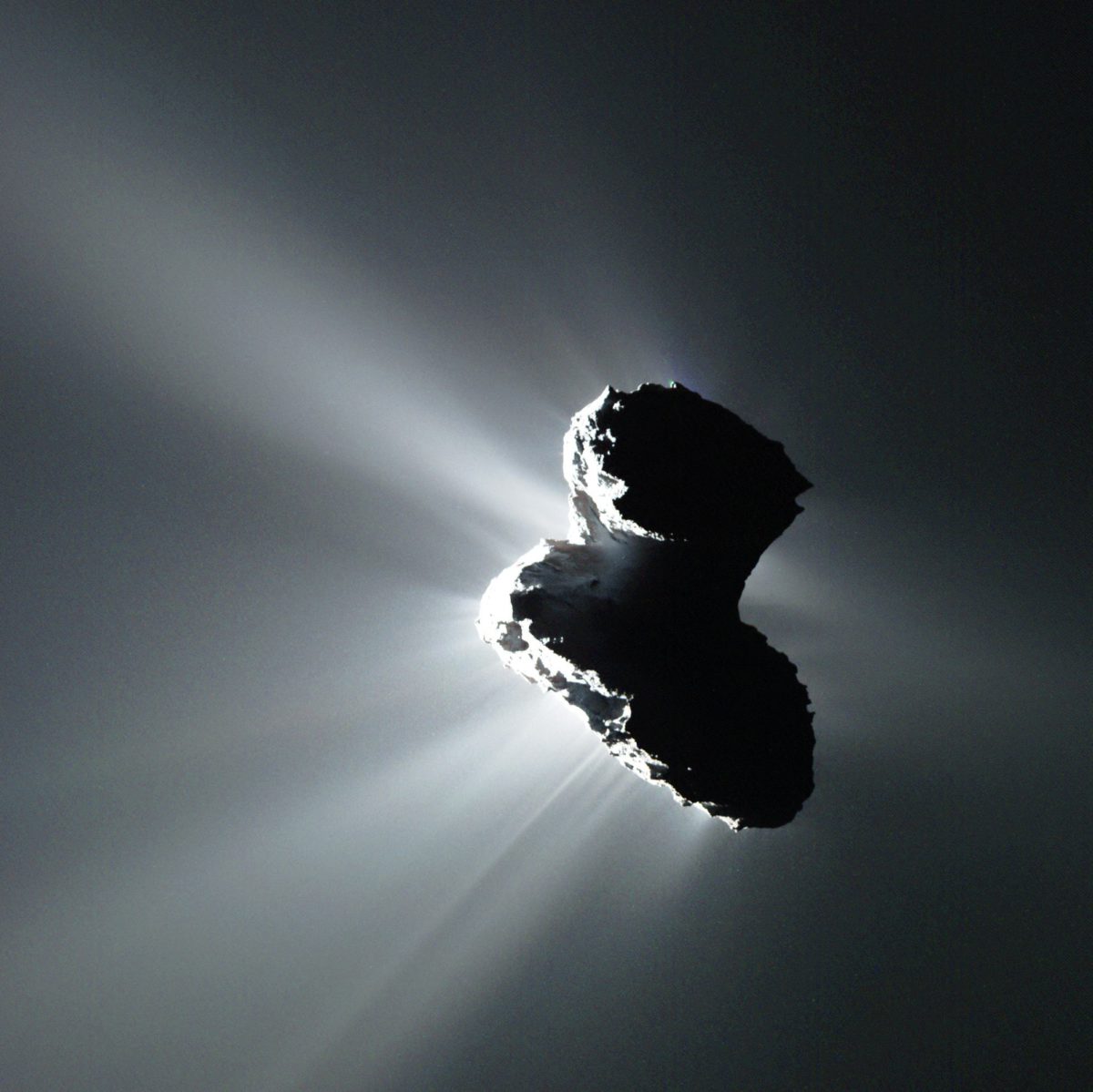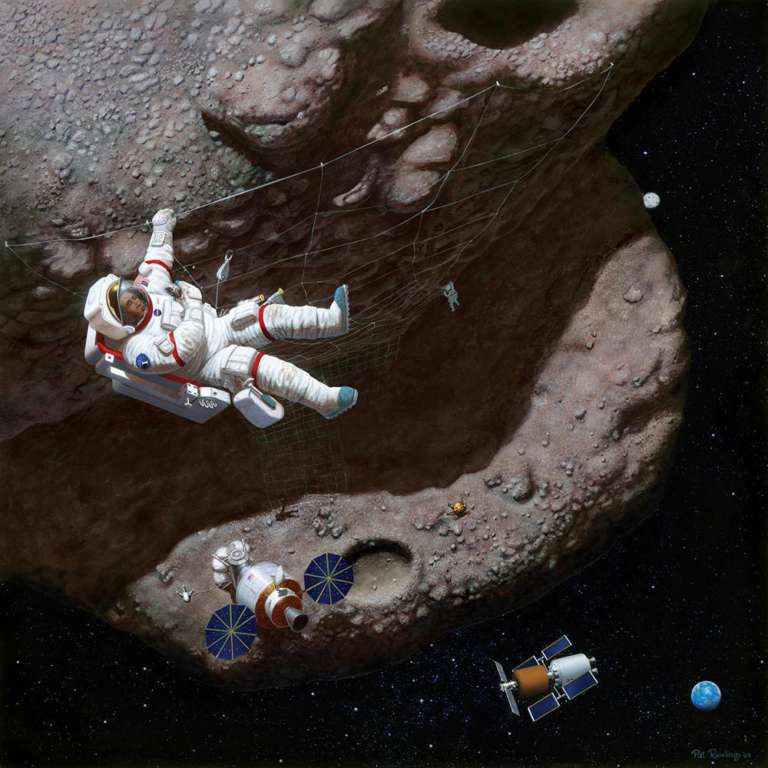
On the Cover: Comet Churyumov-Gerasimenko’s surface has been ravaged by close passages around the Sun. Pits mark the sources of dusty comet jets, and scalloped cliffs have receded and collapsed to generate dusty ponds of comet material. Bluer areas in this false-color image hint at the presence of frozen water and other volatile compounds.
Download PDF
CONTENTS
Mike Constantine looks back at humans’ first landing on the Moon.
Martin Rubin and Cecilia Tubiana report some of the fascinating science returned by ESA’s flagship mission
Makoto Yoshikawa and Elizabeth Tasker explain the unexpected challenges of Hayabusa2’s multiple asteroid landings.
Space on Earth
Precise Movements
We highlight the human workers who make robotic space missions succeed.
Emily Lakdawalla admires a new view of Jupiter’s swirling storms.
Your Place In Space
Space Defense for Us All
Bill Nye invites us to help defend the planet from a huge rock.
The first of two new columns rounds up all the ways Society members are making a difference for space.
Get Involved
Help Defend the Earth From Asteroids
Do you want to participate in space exploration? Get involved with The Planetary Society!
Bruce Betts looks forward to solar and lunar eclipses plus a meteor shower.
Emily Lakdawalla brings us up to date with all the robots traveling beyond Earth.
Precise Movements: Earth-Bound Tracking Devices Help Manage Spacecraft

Snapshots From Space

JUNO captured a swirling region of bright clouds in the wake of a cyclonic storm as it dove toward its 18th close encounter with Jupiter on 12 February 2019. At left is the turbulent, blue-tinted pole; at right, the polar clouds give way to the pinker belts and zones of Jupiter’s midlatitudes. The Juno team posts their images in raw, relatively unprocessed form on the web as soon as they land on Earth—and wait for members of the public to process them. This image is the result of an automated processing pipeline developed by Gerald Eichstädt of Germany, followed by further enhancement by Seán Doran of Ireland.
See more amateur-processed space images.
Space Defense for Us All
Your Membership Dollars at Work to Save the Planet
Bill Nye is chief executive officer of The Planetary Society.
Life is uncertain, but you can be sure of this: Earth will be hit by a huge rock some day—or night. The chance is 100 percent. The thing we don’t know is when. It could happen tomorrow, or it could be 2,356 years from this afternoon, but it will happen. If you’re a member, you are doing something about it. Thank you.
Looking for a typical asteroid is like looking for a typical charcoal briquette…in the dark. I mean the absolute pitch-black, sooty-jet, tar-pit dark. However, dark as they are, asteroids glow in the infrared because they’re warmer than space. They’re at about 150 Kelvins (150 degrees Celsius above absolute zero or minus 190 degrees Fahrenheit). That’s why we at The Planetary Society provide our Gene Shoemaker Near-Earth Object grants to amateur astronomers who keep a lookout, and we advocate strongly to ensure governments continue to invest in more observations and more space missions to near-Earth asteroids and comets. Thanks again for your support.
Let’s say we found an asteroid headed for us, crossing Earth’s orbit on a collision course. What would we do about it? We have to think about a hands-free course correction—a gentle tug or nudge from a spacecraft just big enough to ensure the object crosses our orbit when we’re not there.
Several far-out but reasonable schemes have been proposed. The gravity tractor is an idea for a spacecraft so massive that its gravity could act like a tow rope, pulling the potential impactor aside. The kinetic impactor concept would slam one or more spacecraft into a dangerous asteroid to alter its course. You might think a nuclear weapon would do the trick. It might, but it might cause other problems. Blasting an object in deep space far enough in advance to deflect it might turn it into interplanetary buckshot, which would hit Earth just as hard as the original unshattered object would have, only more spread out. Ouch.
hope you’re familiar with the Laser Bees idea. We supported some early lab research at the University of Strathclyde in Scotland. The idea is that we’d build spacecraft outfitted with lasers driven by solar panels. We’d concentrate laser beams onto a promising area of an asteroid. The ablating (burning off) material would have momentum, which would nudge the asteroid onto an ever-soslightly different course. As an engineer, this is my favorite plan.
In any scheme, the key is early detection. A timely nudge could save us all. I cannot help but recall the last line in the movie The Thing From Another World. The journalist warns us: “Keep looking. Keep watching the sky.”
Your Impact

Help Defend the Earth From Asteroids
Our pale blue dot is sitting in a cosmic shooting gallery. Asteroid and comet impacts, while not common, are very real threats. You can make an impact (get it?) in the battle against threatening asteroids. Here’s how:
Get Educated
Check out our new Asteroid Defense 101, a short course about the threat of asteroid impact and what we can do to prevent it.
Teach Others
Download our Planetary Defense Toolkit and raise awareness of the asteroid threat in your local community.
Support Directly
For 22 years, the Society has supported asteroid hunters through our Shoemaker Near-Earth Object Grants. Donate by 30 June, and your gift will be matched, dollar for dollar, up to $15,000.
Be Loud
#AsteroidDay is 30 June. This United Nations-recognized global awareness day marks the 111st anniversary of the Tunguska impact event. Tell your representatives in Congress to prioritize the issue of protecting Earth from asteroids so that when the next threat arrives, we’re ready.
Be Visible
The city-sized asteroid that doomed the dinosaurs 65 million years ago shall not be forgotten. Remember Chicxulub! Buy your shirt and support our efforts.
More ways to Get Involved in Space Exploration This Season
LightSail 2
The world’s first controlled solar sail flight in Earth orbit is ready for launch— thanks to you. Keep your eyes on sail.planetary.org for updates about our launch aboard a SpaceX Falcon Heavy rocket.
Total Solar Eclipse South Pacific, Chile, and Argentina
On 2 July, invite your friends to witness one of humanity’s most transformative celestial experiences: a total solar eclipse.
Celebrate the Greatest Feat of Human Exploration in History With Us
Humans’ first footprints marked the Moon 50 years ago on 20 July. Listen to the fascinating stories behind the mission in our multi-part podcast special, The Political History of Apollo.
What does the Apollo anniversary mean to you? Share your story at [email protected] or #MyApolloStory on social media.
Space Advocacy 101
School’s out! But that doesn’t mean classes are done. Now’s the time to level up your United States space advocacy expertise. Take our free online course.
What's Up?
By Bruce Betts
In the Sky
On 2 July, there will be a total solar eclipse visible from parts of the southern Pacific, Chile, and Argentina, with a partial solar eclipse visible from much of South America. On 16 July, a partial lunar eclipse will be visible throughout much of Europe, Africa, and western and central Asia. The Perseid meteor shower peaks 12-13 August, with increased activity several days before and after, but the Moon will be almost full at the peak, limiting the number of meteors visible. Bright Jupiter and yellowish Saturn are visible in the evening sky going from east to west as the weeks pass.
Random Space Fact
The 6 Apollo missions that landed humans on the Moon brought to Earth a total of 382 kilograms (842 pounds) of rocks, core samples, pebbles, sand, and dust from the lunar surface. There were 2,200 separate samples.
Trivia Contest
Our December Solstice contest winner is Joel Beebe of Ann Arbor, Michigan. Congratulations! The question was: Who were the final members of the backup crew for the Apollo 8 mission? The answer: Neil A. Armstrong, Edwin E. Aldrin, Jr., and Fred W. Haise, Jr.
Try to win a copy of Astronomy for Kids: How to Explore Outer Space with Binoculars, a Telescope, or Just Your Eyes! by Bruce Betts and a Planetary Radio T-shirt by answering this question:
What was the first spacecraft mission to return samples from a comet?
Email your answer to [email protected] or mail your answer to The Planetary Report, 60 S. Los Robles Ave., Pasadena, CA 91101. Make sure you include the answer and your name, mailing address, and email address (if you have one). By entering this contest, you are authorizing The Planetary Report to publish your name and hometown. Submissions must be received by 1 September 2019. The winner will be chosen in a random drawing from among all the correct entries received.
For a weekly dose of “What’s Up?” complete with humor, a weekly trivia contest, and a range of significant space and science-fiction guests, listen to Planetary Radio at planetary.org/radio.
Where We Are
An At-A-Glance Spacecraft Locator



Astronomical Art

The Planetary Report • June Solstice 2019
Help advance space science and exploration! Become a member of The Planetary Society and you'll receive the full PDF and print versions of The Planetary Report.


 Explore Worlds
Explore Worlds Find Life
Find Life Defend Earth
Defend Earth

